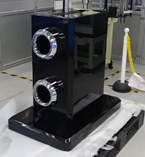- Products / Technology
- Technology
- SDGs /CSR /Environment
- NEWAug. 30, 2021
Daihatsu Develops Disinfection Device “MIRACLEBUSTER” Applying Vehicle Technologies and Starts Disinfection of Nearby Facilities
Aug. 30, 2021
Daihatsu Motor Co., Ltd.
 MIRACLEBUSTER
MIRACLEBUSTER
 Image of use in an environment without people
Image of use in an environment without people
Daihatsu Motor Co., Ltd. (hereinafter “Daihatsu”) has developed “MIRACLEBUSTER”*1—a device that uses ozone which has disinfection effect—and started disinfection of facilities in Kurume City, Fukuoka Prefecture on August 30.
Daihatsu’s Research Institute of Car and Life-style also developed the ultraviolet (UV) disinfection device “ULTRABUSTER”—which was announced on February 25, 2021—to provide safe environments with peace of mind to employees and customers from nearby regions. This time, MIRACLEBUSTER was developed jointly with NGK SPARK PLUG CO., LTD. (headquarters: Mizuho-ku, Nagoya City; Representative Director and President: Takeshi Kawai).
As part of vehicle manufacturing, Daihatsu undertakes technology development in using plasma to process particulate matter (PM) found in exhaust gas. Daihatsu embarked on development to see if ozone—produced as a by-product when using plasma—can be used for disinfection. The MIRACLEBUSTER developed this time was able to achieve efficient spatial disinfection*2 by applying exhaust gas processing technology for processing PM within a short period of time. Besides spaces, it can also disinfect the surfaces of objects. Its effect was confirmed in tests conducted by a specialized agency*3, with airborne virus in a room (25 m3) reduced by 99.4% in five minutes and virus found on the surfaces of objects reduced by 99.93% in 60 minutes.
Going forward, Daihatsu will continue to aim to be a company that plays an intimate part in the lives of its customers based on its “Light you up” approach to provide optimal mobility to every one of its customers, and at the same time, encourage initiatives that can contribute to community activities.
*1: Assumes disinfection in an environment without people. The device comes with its own ozone decomposition catalyst and automatically reduces ozone to a safe concentration after disinfection.
*2: Ozone generation of 12 g/hr per unit. Maximum of approximately 48 g/hr when four units are used together.
*3:
Test agency: Kitasato Research Center for Environmental Science
Test method: Measurement of change in airborne virus count in a test environment of 25 m3 and surface virus count in a test environment of 1 m3
Test results: Reduced by 99.4% in approximately five minutes (airborne virus) and 99.3% in 60 minutes (virus on gauze surface)
<Test number> KRCES No. 2020_0098 and KRCES No. 2020_0281
This is not a test for COVID-19 (SARS-CoV-2). This is not demonstrated effect in an actual use environment. Effects differ according to the use environment and room conditions.




